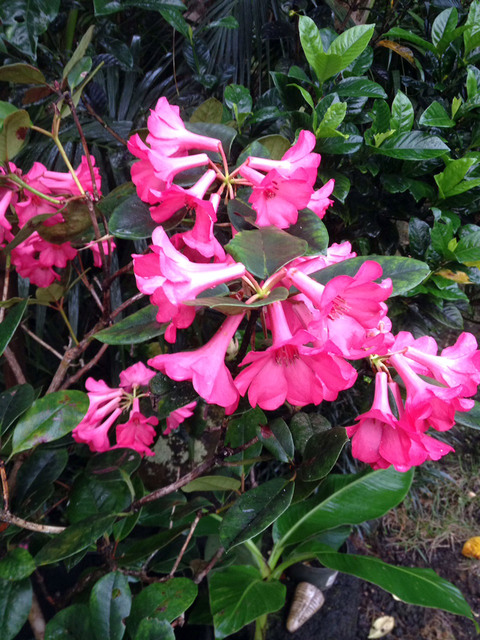April showers bring May flowers and with longer days, most folks already are getting “Hawaiian Spring Fever.” ADVERTISING April showers bring May flowers and with longer days, most folks already are getting “Hawaiian Spring Fever.” This means getting close to
April showers bring May flowers and with longer days, most folks already are getting “Hawaiian Spring Fever.”
This means getting close to nature with plants.
Throughout the northwest United States and Japan, one of the highlights of spring is the mass blooming of azaleas and rhododendrons. In Hawaii, these attractive garden shrubs are popular in cool, mauka areas. This spring, the plants also are available as potted house plants at our local garden shops and nurseries.
If you are looking for some spring color to perk up your home or garden, azaleas and their relatives, the Vireya rhododendrons, are a natural. These are great gifts for Mother’s Day. In fact, they are perfect for a gift just about anytime, since living gifts are gifts of aloha.
If you’re not quite sure about azaleas and you want to know what you are buying, here are a few tips to remember:
• Azaleas are part of a small but widely distributed family found in many parts of the world. They usually are found in cool, moist regions such as the Pacific Northwest and the Himalayas. Some species are even found on high mountains such as Kinabalu in Borneo. Many in this group are adapted to temperate regions, but some have found Hawaii a good place to live.
• Some of the azalea varieties you will find on the market bloom in reds, whites, pinks, salmons and even mixes of white-pink and white-red. Azaleas are slow growing in Hawaii. A good specimen 6 to 8 inches high takes at least two years to reach the market.
• They are not easily grown from cuttings. That is why a gift of an azalea is something special. Many Vireyas on the other hand may easily be grown from cuttings and some become large shrubs. This family of flowering plants is extremely variable, but have certain characteristics in common. When you buy you’re azalea or Vireya living spring bouquet, they are easy to care for if you follow a few simple rules.
• Azalea plants won’t tolerate a daily scrub-down, but they will take on a healthy look with an occasional leaf washing. Dirty foliage is unattractive. If the leaves get heavy with dust, wash them off with water. This will discourage insect and mite buildup. The proper watering of plants is more important than giving them a bath. In general, plants require a thorough soaking at least once a week. In warmer temperatures or air-conditioning, plants might require more water.
• Applying too little moisture might allow the soil in the bottom of the container to dry out, causing the plant to wilt or die. On the other hand, keeping the plant roots soggy also will cause injury. Make sure the pot has sufficient drainage. Azaleas and Vireyas grow well at temperatures between 60 and 70 degrees.
• Therefore, protect the plants from being broiled alive by direct sun and hot or windy areas. In cool mauka areas, they may be placed in sun. Like people, they like their food served at regular intervals. Special acid azalea fertilizers are available. The best suggestion of feeding is to follow the directions on the plant food container. Since they are slow growers, they should only need fertilizer once every two to three months.
Here are some tips on diagnosing plant troubles:
• Brown tips or burned margins might mean you’ve applied too much fertilizer, you’ve let the plant roots dry out or you’ve let the plant become wind burned.
• Yellowing of leaves indicates overwatering, poor drainage or poor soil aeration. Small leaves suggest a tight or heavy soil mixture, lack of fertilizer or not enough moisture.
• Weak growth or light green color on otherwise healthy foliage indicates too much light, lack of fertilizer, root-rot or poor root systems.
• Yellowing, wilting or soft growth means too much heat or root injury. Remember, azaleas and their cousins require an acid soil.
If you decide to plant them in the garden or repot them, give plants a mix high in peat moss. Make sure you don’t plant them in soils that are high in calcium. Avoid planting in concrete containers, near sidewalks or concrete foundations since these contain calcium and will cause nutrient deficiencies. Also remember, they should not be planted near the ocean or in hot, dry or windy areas. It is not always easy to find Vireya rhododendrons at local garden shops and nurseries.
The best bet is to get acquainted with folks in the local chapter of the American Rhododendron Society. You can connect with them by contacting the club’s president, Bill Miller, at 982-8290. You also can check out the group’s website at www.HawaiiVireyaARS.org for meeting dates and news.
This information is supplied by the University of Hawaii College of Tropical Agriculture and Human Resources. For further information, contact the office near you.



